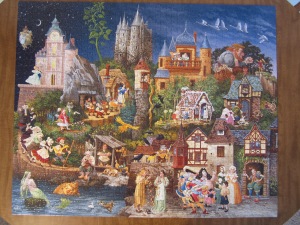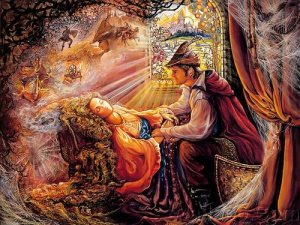 According to dictionary.com, a fairy tale is “a story, usually for children, about elves hobgoblins, dragons, fairies, or other magical creatures.’ While this is partially true, this definition nowhere near covers an actual fairytale. There is so much more to these kinds of stories than simply magical creatures; there is action and adventure, love, death. Had the Brothers Grimm seen this definition of a fairytale, they would be outraged because their tales tell so much more. As Heidi Anne Heiner puts it, when asked what a fairy tale is, she answers “I am not going to give a neat pat answer since I don’t think one exists.” Regardless of the inability to precisely define a fairy tale, working definitions exist that almost always include aspects of the story such as magic, comparisons to reality, and action.
According to dictionary.com, a fairy tale is “a story, usually for children, about elves hobgoblins, dragons, fairies, or other magical creatures.’ While this is partially true, this definition nowhere near covers an actual fairytale. There is so much more to these kinds of stories than simply magical creatures; there is action and adventure, love, death. Had the Brothers Grimm seen this definition of a fairytale, they would be outraged because their tales tell so much more. As Heidi Anne Heiner puts it, when asked what a fairy tale is, she answers “I am not going to give a neat pat answer since I don’t think one exists.” Regardless of the inability to precisely define a fairy tale, working definitions exist that almost always include aspects of the story such as magic, comparisons to reality, and action.
This definition gets one thing right; at the heart of every fairytale is magic. However, this is not just any magic. In fairy tales, the “real fairy tale hero is not astonished by miracles and magic (Lüthi 46). Magic is an innate part of a fairy tale and, as such, almost no one in the story is surprised when a duck talks, when the hero has a supernatural power, or when a magical monster is terrorizing a town. There is no element of disbelief or wonder in a fairy tale when it comes to magic- the exact opposite of how it is in the real world. Ducks cannot talk, heroes are just ordinary people, and monsters are plain old humans.
However, ironically enough, fairy tales are considered utopian worlds in miniature. At first, one might question this assumption, deeming it absurd because magic does not exist in the real world. Although, upon further thought, this conclusion is not impossible to reach. Take, for example, the  Brothers Grimm version of “Sleeping Beauty.” In this story, a girl is blessed with the best gifts anyone could ever ask for. Then, a curse is placed upon her in which she will fall asleep for one hundred years on her fifteenth birthday. Though this curse comes to pass, Aurora is saved by a handsome prince and they, and the rest of the kingdom, proceed to live happily ever after. In this fairy tale, evil is thwarted while good is triumphant. Aurora overcomes the curse that has been placed upon her and thus resumes her perfect life as a princess. Though the evil aspect of the story may not seem ideal, there can be no good without evil. Thus, this story represents an ideal world in miniature (Lüthi).
Brothers Grimm version of “Sleeping Beauty.” In this story, a girl is blessed with the best gifts anyone could ever ask for. Then, a curse is placed upon her in which she will fall asleep for one hundred years on her fifteenth birthday. Though this curse comes to pass, Aurora is saved by a handsome prince and they, and the rest of the kingdom, proceed to live happily ever after. In this fairy tale, evil is thwarted while good is triumphant. Aurora overcomes the curse that has been placed upon her and thus resumes her perfect life as a princess. Though the evil aspect of the story may not seem ideal, there can be no good without evil. Thus, this story represents an ideal world in miniature (Lüthi).
Another aspect of fairy tales that draws people to them is their disposal of description as well as their abundance of action, which go hand in hand with each other. The fairy tale lives for action. Especially in the Brothers Grimm stories, detail is done away with in favor of focusing most of the story on the action scenes. Therefore, characters’ appearances are not usually given, nor is the description of the scenery surrounding the hero. Instead, only the fight and rescue scenes are actually detailed so that the readers have a clear sense of what is going on. Action is what makes a fairy tale. Without it, there would be no plot.
Finally, what makes each specific fairy tale is the zeitgeist, or the spirit of a certain time. The zeitgeist accounts for almost all variations in fairy tales from different countries, along with different times. What goes into a fairy tale all depends on who the target audience is and what the writers hope to accomplish in creating the story. For example, the Grimm Brothers wrote their fairy tales primarily for the German middle class and aristocracy. Therefore, they focused on upholding the morals of the time so they did away with allusions to sex and other inappropriate behavior in favor of more refined, less provocative ideals, while also trying to retain the history of Germany in their stories. In comparison, Walt Disney’s version of the Brothers Grimm tales are even more censored because at that time, children were the target audience. Also, the first Disney movies were produced during the Great Depression, time of pain and sorrow. In order to counter this sadness, Disney incorporated themes such as hopefulness and happiness. Though the target audience was children during the 1930’s and 40’s, Disney’s movies are essentially for everyone and are timeless in the sense that they are still watched today.
Fairy tales are such versatile stories that creating a concise definition is futile and impossible. Doing so is the equivalent of attempting to verbally describe a color. Though fairy tales are not all alike, they all share similar characteristics that separate them from other stories, primarily that they are full of magic, action, are miniature realities, and represent the time in which they were written in some way, either directly or indirectly.
References
http://www.surlalunefairytales.com/introduction/ftdefinition.html
http://fairytalescrapbook.tumblr.com/post/28207378402/forestoffairytales-sleeping-beauty
https://alphacentauri32.wordpress.com/2011/12/12/fairy-tales/

